Creating an environment where people can work
with energy and good health
Basic concepts
We are working to develop, monitor, maintain, and improve systems and workplace environments that emphasize DE&I* so that people from diverse backgrounds and life stages can continue to work with vitality and good health.
*DE&I: Diversity, Equity & Inclusion
Health management initiatives
Declaration on Health
The Nankai Group considers the maintenance of the health of all employees and the creation of an environment in which each of its diverse human resources can fulfil their full potential as one of its top management priorities, and in June 2022 the Company established the Health Declaration. At the same time, we established a Health Management Promotion Committee to ensure company-wide and cross-sectional cooperation on health management initiatives. From now on, specific targets will be set based on current issues, and the achievement of these targets will be checked to ensure that they are promoted.
Declaration on Health
Issued in June, 2022
Nankai Electric Railway Co., Ltd. is on a mission to provide customers with “safety and security” and to continue to enrich the life in areas along our railway lines as a company that provides public transportation services as its core business. We believe that in order to fulfill this mission, our employees must be healthy physically and mentally.
We are committed to creating lively places for people to work together so that many customers and individual employees can feel optimistic for the future, or “Nankaiine.” We declare that we will grow together with the community as a sustainable company with a strong will to create the future by helping our employees stay healthy and promote their health.
Health Management Promotion Committee
We have established the Health Management Promotion Committee, chaired by the director in charge of human resources and composed of representatives from each department, industrial physicians, Nankai Electric Railway Health Insurance Association, and the Human Resources Department, to determine specific goals and policy measures. This Promotion Committee promotes collaborative health based on the Health Management Strategy Map and effectively implements health management.
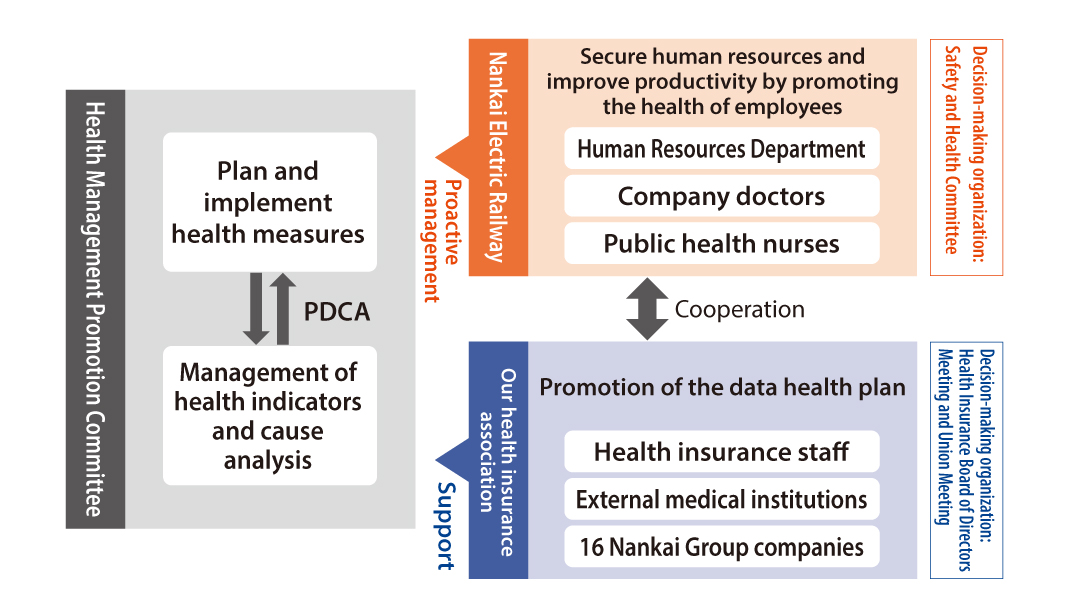

Develop a health management strategy map
In order to create and visualize our health management strategy, we have formulated a health management strategy map for FY2023. By promoting health measures based on this strategic map, we will strive to continuously improve the level of health of our employees, as well as to achieve the important sustainable theme of “creating a workplace and people where each and every employee can fulfill his or her potential.
Implement measures to maintain and improve both mental and physical health
In accordance with the guidelines of the Ministry of Health, Labour and Welfare, we are implementing measures to maintain and promote both physical and mental health.
With regard to understanding the health status of employees, we are striving for early detection and prevention of diseases through management, health guidance, health education, and health counseling in accordance with in-house health management standards, led by our on-site occupational health staff.
In FY2023, we established a healthcare department within the Human Resources Department to focus on preventative medicineand develop new initiatives by occupational physicians and publichealth nurses.
| FY2020 | FY2021 | FY2022 | FY2023 | ||
| Periodic health examination visit rate | % | 100.0 | 100.0 | 100.0 | 100.0 |
| Control rates for high-risk individuals*1 | % | ― | ― | 74.3 | 73.7 |
| Stress check inspection rate | % | 99.0 | 98.0 | 94.0 | 95.5 |
| Average overtime per month | hours | 25.0 | 23.7 | 24.3 | 24.8 |
| Smoking rate | % | 26.9 | 26.9 | 27.3 | 26.7 |
| Percentage of people who are regular exercisers*2 | % | 41.3 | 41.6 | 42.9 | 45.0 |
1 Percentage of those who received a medical examination at a hospital among those recommended to receive a medical examination
2 Percentage of those who walk or engage in equivalent physical activity for at least one hour a day in their daily lives
Specific measures and results
As for mental health, we provide self-care (stress check), line care (training sessions for managers and supervisors), an external consultation service, and counseling by a designated psychiatrist. In addition, we introduced the “Rework Trial Program” as a system to support the smooth return to work of employees on leave due to mental health problems, and one employee returned to work in FY2023.
Stress checks are conducted once a year. (Stress check inspection rate in FY2023 was 95.5%)
In addition to mental health matters, industrial physicians and public health nurses provide health guidance on general illnesses such as lifestyle-related diseases, and focus on preventive medicine.
As appropriate, public health nurses educate employees internally about the negative effects of smoking on their health. The Nankai Electric Railway Health Insurance Association also partially subsidizes the cost of treatment at smoking cessation clinics.
In FY2024, we are also working on anti-smoking measures by integrating smoking areas at the head office and providing smoking cessation support medicines free of charge.
Our dining rooms are installed with opinion boxes so that employees’ opinions are reflected in improvements to employee dining rooms. We work with cooperating companies to reflect employees’ requests for menus, if any, so that we can offer dishes that reflect their views.
In November 2023, we renovated the cafeteria at our headquarters in order for employees to perform their work in good physical and mental condition. In addition to improving health through the cafeteria menu, the cafeteria space was reorganized to make it a space conducive to the prevention of loss of concentration and activation of communication.
Starting in October 2023, as a response to exceeding legal working hours, we have extended the scope to include head office employees who worked over 60 hours for the last three consecutive months. We recommend they consult with the industrial physician regarding long working hours. Our plan is to gradually expand this guidance to operating divisions.
To address mental and physical health conditions and women-specific health issues, a women's health consultation service was established in FY2024.
Six companies in our group, Nankai Grief Support Corporation, Nankai Real Estate Corporation, Nankai Rolling Stock Industry Corporation, Suminoe Kogyo Corporation, Nankai System Solutions Corporation, and Nankai Management Service Corporation, have been certified as “Excellent Health Management Corporations 2024” (small and medium size corporations category).
Occupational health and safety
Occupational Safety Management System
To promote employees' welfare and ensure healthy business development, we have set up a Health and Safety Committee to prevent occupational accidents and enhance healthcare management at each workplace. The Health and Safety Committee comprises a Central Health and Safety Committee and Regional Health and Safety Committees.
The Central Health and Safety Committee facilitates communication among the Regional Health and Safety Committees and comprehensively oversees health and safety matters across the company. Chaired by the General Manager of the Group Management Division, the committee includes the chairpersons of each Regional Health and Safety Committee and industrial physicians. The chairperson convenes meetings as needed to establish fundamental policies for comprehensive health and safety management, review proposals from the Regional Safety and Health Committees, and address occupational accidents and healthcare management.
The Regional Health and Safety Committees focus on specific measures related to decisions made by the Central Health and Safety Committee and matters related to health and safety within their respective divisions. The general health and safety managers, who chair these committees, convene meetings to discuss matters directed by the Central Health and Safety Committee and address regional issues related to occupational accident prevention, healthcare management, and workplace ethics.
Implementation and results of measures to prevent occupational accidents with the aim of achieving zero accidents
The majority of work-related accidents are caused by unsafe behaviors. To prevent this, we conduct safety activities such as senior-proofing the workplace, building a system to predict hazards and prevent near miss accidents, and conducting risk assessments; identify where and what kind of risk factors exist in the workplace; formulate countermeasures; and raise awareness of hazards throughout the workplace. For work-related accidents that are caused by the actions of third parties, we take countermeasures by exchanging information with other companies in the same industry and utilizing the "Manual to Prevent Incidents Caused by Third Parties." In FY2023, there were 10 work-related accidents.*1
We introduced a risk assessment program to reduce the number of occupational accidents by identifying and quantifying a variety of hazards (risks) in the workplaces, evaluating the magnitude of the risk, and putting countermeasures in place (eliminate and reduce risks) before accidents occur. In FY2023, we carried out 110 risk assessments. Although we cannot implement countermeasures for all risks immediately, we recognize the risks and continue to address them until they are at risk level A (acceptable level).
In addition, our company and labor union officers conduct workplace safety patrols during the National Safety Week. We inspect the workplaces and report and discuss measures to prevent occupational accidents.
1 Includes two cases of violent behavior by a third party
Lost work frequency rate※2 ※3
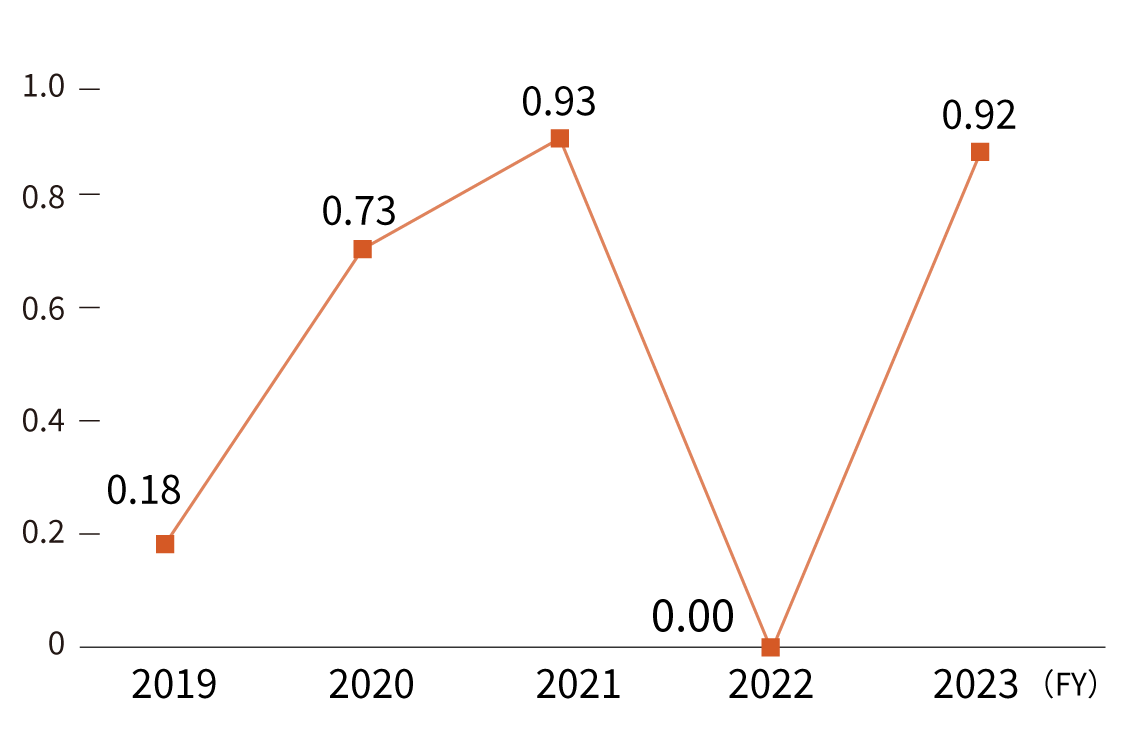
※2 Lost time incident rate = Number of casualties due to occupational accidents (more than one day lost from work) ÷ Total number of working hours x 1,000,000
※3 Scope of our identification : full-time employees(including non-regular employees) and contract employee,excluding seconded employees
Number of accidents
Work accidents (FY2023)
ten work accidents (Business disasters 10 (self-inflicted damage 8 Third party violence 2)
2 commuting accidents
Mental health training
FY2022
Number of participants:60 employees(employees in management and supervisory positions)
Health and safety training
FY2023
Number of participants:94 employees(new employees)
Initiatives to support balancing work with childcare and nursing care
The Nankai Group has set "providing the industry's best working environment for human resources engaged in childcare, nursing care, etc., and senior human resources" as a medium-term goal.
In addition to our childcare leave system and our nursing care leave and holiday system, we are working to "strengthen support for balancing work and childcare" through the following measures. In addition, we make sure that employees on childcare leave will have a smooth return to work by sending them periodic internal newsletters (digital version launched in June 2021) and having them hold meetings with their supervisors.
| Fiscal year | Measures |
|---|---|
| FY2019 | Introduction of a flextime system that allows employees to choose their start time |
| FY2021 | Extension of the period during which employees can use the shortened working hours system for childcare until the start of their child’s fifth year of elementary school |
| FY2022 | Introduction of a telecommuting system |
| FY2023 | Introduction of baby support leave (up to ten days of paid leave that can be taken by both men and women during the postpartum period) Newly added “hospital visits for infertility treatment” as a reason for taking stock leave |
| FY2024 | Review of family allowances (increase in family allowances for children) Implementation of Papa Talk!, a social event for male parents |
As a result of these initiatives, the proportion of female employees who have taken childcare leave after giving birth and the rate of returning to work after taking leave has been 100% for ten consecutive years. In recent years, the number of male employees taking childcare leave has been on the rise, and the percentage of male employees taking childcare leave and other leave for childcare purposes in FY2023 was an extremely high 91.1%.
These initiatives were implemented after formulating a general business-owner action plan in accordance with the Law for Measures to Support the Development of the Next Generation. In March 2015, we obtained the Kurumin Mark after meeting the criteria as a company that supports child-rearing, as defined by the Ministry of Health, Labour and Welfare.
Acquisition rate of childcare leave, etc. and leave for childcare purposes (non-consolidated)
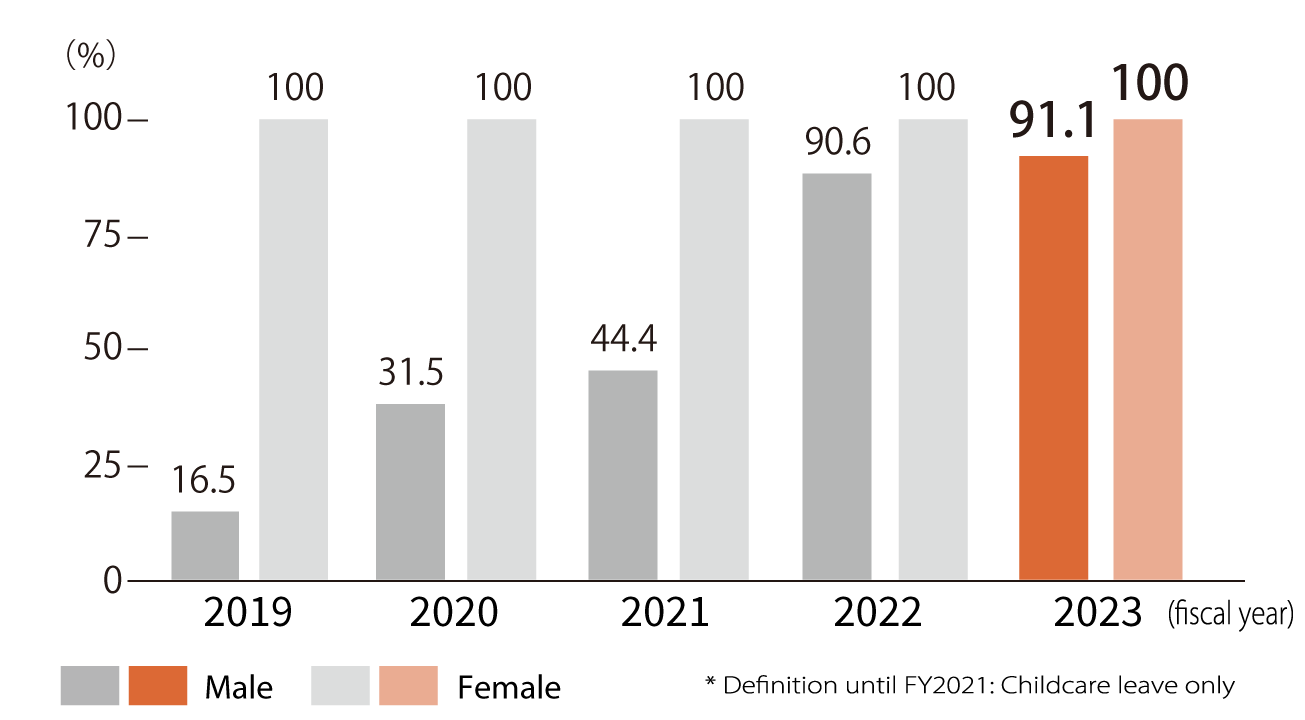
Initiatives for work style reform
Promoting the acquisition of annual paid leave
Our company has introduced a planned annual leave system and is promoting the taking of annual leave in half-day units. In addition, in the railway operations department, we ensure that everyone can take their paid annual leave, even though it is a workplace where personnel are required to work, and we are working to ensure that operations can continue while employees are on leave. As a result, the rate of annual paid leave taken at our company has been high for five consecutive years, at over 90% (96.6% in FY2023).
Annual paid leave take-up rate (non-consolidated)
| FY2019 | FY2020 | FY2021 | FY2022 | FY2023 |
|---|---|---|---|---|
| 92.6% | 90.9% | 90.1% | 96.9% | 96.6% |
Initiatives for work style reform Flexible working hours and dress codes
If any of our employees work overtime in excess of a certain standard, we will promptly liaise with their superior and take steps to improve the situation so that they do not work excessive hours. In addition, with the aim of creating a culture that encourages people to try new things and a working environment that is easy to work in, from FY2023, we have started to implement a flexible dress code that allows employees to wear attire beyond business-style clothing (e.g., suits and ties) at our head office, and we are promoting initiatives that are not bound by the traditional ways of working.
Reduction of overnight work centered on station offices
Since 2024, the company has been reviewing its overall operations and reducing the number of employees working overnight. We have replaced some of the work on a rotating shift system, which involves working from 9 am to 9 am the following day, mainly at the station, with day shift work. By reviewing the way we work, which has traditionally been based on overtime, we strive to increase the number of holidays and improve work-life balance.
“Initiative to Promote Relaxation and Excitement”
In recent years, employee engagement, which indicates how much employees trust and are willing to contribute to the company, has been attracting attention in Japan. We have been implementing the "Initiative to Promote Relaxation and Excitement" as an internal activity aimed at creating a workplace full of "Bound for good times."
As part of this initiative, we have launched the Nankaiine Card to increase employee motivation and promote communication among employees. The card has fostered a culture where employees praise one another, which has in turn improved their quality of work. We have also launched a photo-sharing website for employees under the "Railway Ambassador Program," with the aim of educating employees about areas along our railway lines and fostering their pride in these areas. This page is serving as a useful tool to learn about areas along our railway lines in an enjoyable way.
In view of the diversification of employees' welfare needs, we introduced a selective welfare scheme (NICE Plan scheme) in FY2022, which allows employees to use mainly the services of the Group within the scope of the points granted to them. We will continue to improve employee engagement and review our systems on an ongoing basis to ensure that our employees are highly motivated in their work.
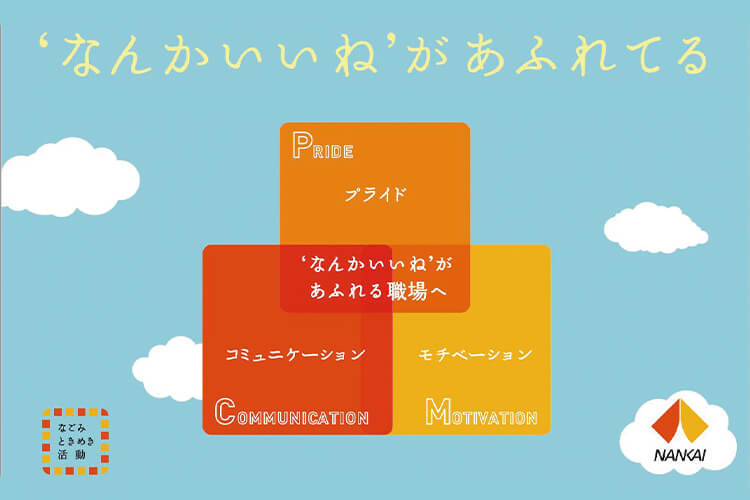
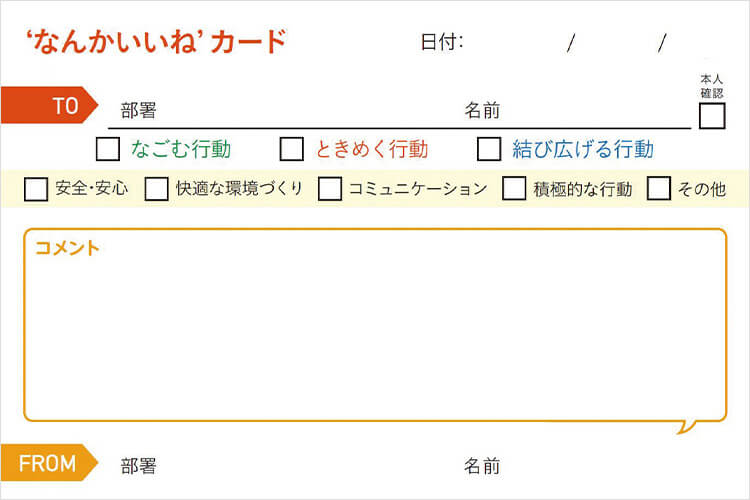
Sustainability Site Map
(materiality)
- Major sustainability themes (materiality)
- Identification processes
- Further seek safety, security, and satisfaction
- Thriving and friendly community development
- Create a future full of dreams
- Achieve an enriched life
- Develop a workplace and staff in a way that enables each person to put their abilities to use
-
Contribute to preserving the global environment
- Environmental philosophy
- Reducing CO2 emissions in response to climate change, promoting the use of renewable energy, and so forth
- Bringing about a circular society
- Preserving biodiversity
- Deepening our environmental management
- Expanding environmental buildings (green buildings)
- Responses to TCFD Recommendations
- Bolster a corporate foundation that is sincere and fair
